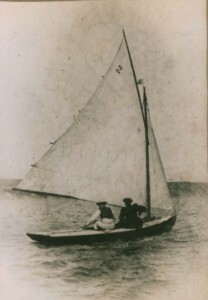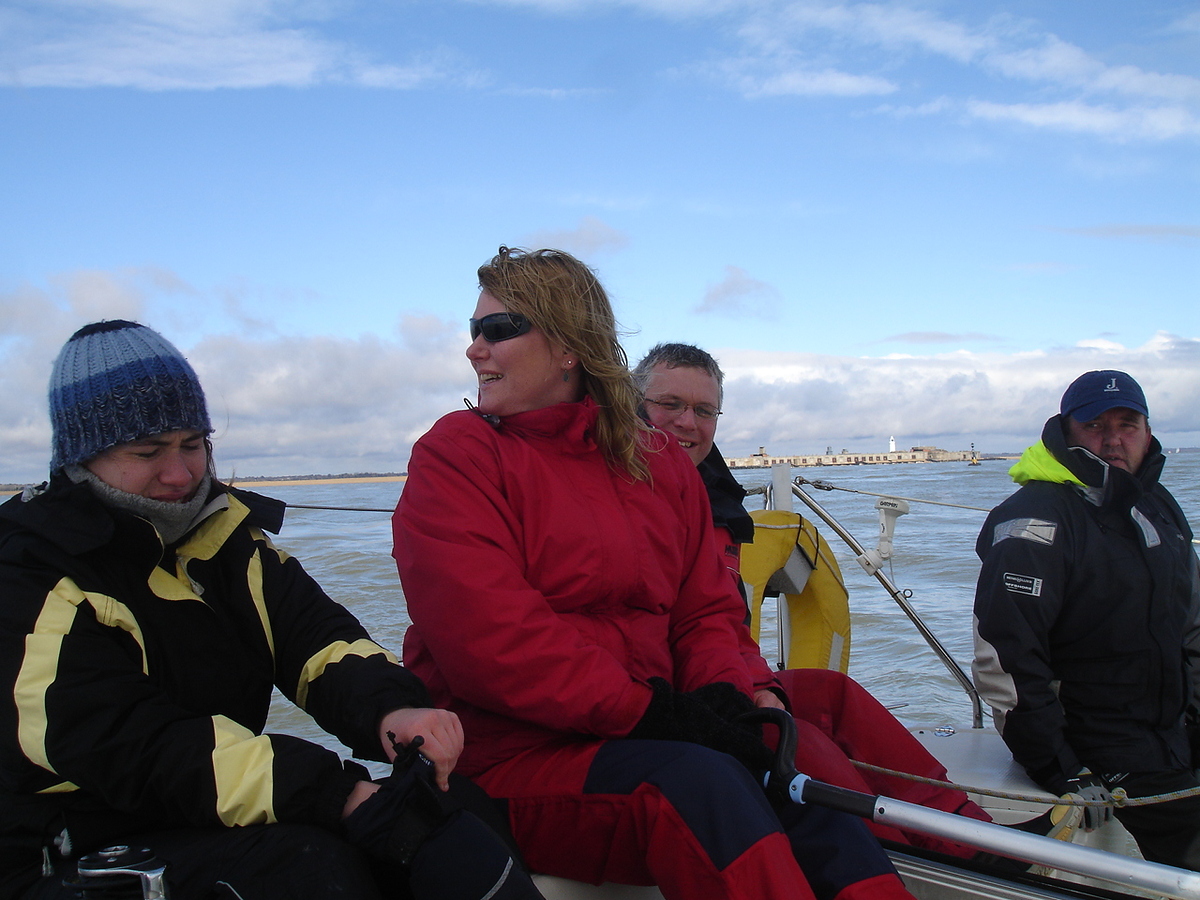'A long haul upwind' - the development of women's sailing in Weymouth

Published 10:10 on 20 Aug 2025 by Stephen Fraser
The process, whereby women became more equal participants with men in the sport of sailing, inevitably mirrors the struggle for women to obtain the vote, especially in the years between the partial success of 1918 and full suffrage in 1928 (see Joyce Marlow 2000, Jenni Murray 2018). Their struggle was against that apparent law of nature by which men had, for the half a century associated with the gradual decline of imperial power, congregated after retirement like woodlice in clubs and societies in London and across the country.
These clubs were closely modelled on the patterns of institutional behaviour, including ideas about the natural inferiority of women, instilled by the services and by the civil careers which imitated them. This process has been studied by many writers, including Tama Starr (1991), Amy Milne-Smith (2011), and Angela Saini (2017).
In spite of the prevalence of these norms, however, women were allowed to join the Weymouth Corinthian Sailing Club from its beginnings in 1902 should they be small boat owners. Indeed, one of the three women members, Mrs McGachen, won a cup in the first season in 1903! Another, Mrs Cunningham, has the distinction of being the first woman to be photographed sailing in the Bay in 1902 (see photo above).
A challenge, to a male hegemony still perceived in many ways as natural, would continue to be provided by outstanding individual contributions from the rare female members. A Mrs Mackenzie-Grieve won the Huxtable Rose Bowl in 1914, but WWI and a severe illness meant that she only continued her success in 1920, when, in order to extend the sailing season, she also presented a cup for a three-race pursuit series. At the annual prizegiving, at which she, with her husband, a naval commander, dutifully in tow, awarded the prizes, hearty cheers were given for Mrs. MacKenzie-Grieve, whose pluck and sporting spirit in sailing her boat in all weathers were the admiration of the whole club.
We might pause to consider the problem for women of sailing in clothing ill-adapted to the activity, and invariably getting wet, with nowhere to change on coming ashore. It is clear from the photo of Mrs Cunningham that her outfit, seemingly borrowed from Dickens’s Mrs Gamp and already very cumbersome, would become impossible if soaked; a photo from the 1930s of the pioneering US woman sailor Fairfax Moody and her sister Betty suggests a development in leisure wear, at least for sunny days. Betty seems to be well-prepared with gloves as well (see first photo below). They are wearing trousers, an alarming post-WW1 cultural shift as far as men were concerned, and as Fairfax Moody ably demonstrated in her sailing! Waterproof clothing was rare if non-existent: at Castle Cove a Mrs McHattie suffered a curious wardrobe fail when she wore a blue suede jacket sailing, and returned soaked to the skin and not just blue with cold, but with dye which had run from the suede!
While Mrs. Mackenzie-Grieve’s achievement is at the time characterised as remarkable partly as a way of containing it, in the ensuing decade, women’s sailing was increasingly normalised in the club. Mrs Mackenzie-Grieve gave up her boat in 1922, by which time the Dorset Daily Press had been persuaded to offer a cup for a Ladies’ Race, which was sailed in blustery conditions by nine contestants, including a Miss Carter representing the newspaper. The cup was won by a Mrs Hownam-Meek, who would lead the development of women’s sailing at what was now Weymouth Sailing Club*, in a manner parallel to her husband’s work both at Weymouth and at Castle Cove.
The following year the youngest competitor was Janet Byles (13), whose sister Elsa won the cup, partly because the Hownam-Meeks were at Cowes; in 1924 Janet then went on to win the first ever Cadets’ race, beating Joan Walford (11) by a close margin, both girls trouncing the boys – the newspaper announced “Girls triumph, boys nowhere in Weymouth sailing race!”
In 1924 the Ladies race was won by another girl Cadet member, Freda Bratby (12), beating some fourteen other competitors. Freda would become famous for being inadvertently torpedoed with her father in their Falcon Merlin in 1928!
Up to this point the boats owned, or on occasion hired, by members and others participating in Club events were heavy clinker-built dayboats 14-20ft long with long shallow draft keels, as seen in the photo of the Cunninghams in 1902. Records show that with their large gaff rigs they could easily be swamped and sometimes capsized and even sunk! Being of very different ages and designs, they were subject to a rudimentary handicapping system usually agreed on before each race.
The appearance of the new, locally-built Falcon class in 1927 changed amateur sailing completely, as at other clubs who developed their own one-design classes. These identical, lighter-built boats with a lifting iron centreplate, were easier and safer to sail, and meant that one-design racing in heats could be sailed, leading to the possibility of greater participation. There were ten entrants for the next Ladies’ race, won in the final by Mrs Saunderson in Buzzard, while Cadet member Doreen Breach built on her success in the Ladies’ Cup in 1926 to take overall victory in the Cadets’ races. In 1928 a total of sixteen Cadet entrants sailed in the four X-boats which had arrived in the Club from Poole as an alternative one-design class; overall winner of the four heats was the daughter of one Captain Brocklebank.**
Women were regularly adding to the membership, though, after the club took over its present premises in 1923, it still took a further ten years to acknowledge their presence by building a changing room for them. The male hierarchy was then immediately forced to acknowledge, in 1932, that the cost of building was justified by the increase in the Ladies’ Membership alone! It is interesting that this building is referred to by club historian Jim Hayes as a ‘Hen house’ even though no such term is ever used in the original minutes; this was then carried over into the revised history without Hayes’s inverted commas – such being the power of residual sexist narratives…
In spite of this significant territorial gain, women would not be admitted to the clubs annual dinners, that last bastion of male mess-life, until their transformation in 1935 into the annual Dinner and Dance – a more important milestone than is generally appreciated.
After WW2 women’s sailing developed steadily. The first female commodore in Weymouth was Mrs Wingfield-Digby in 1946 at Castle Cove fifty years before Melita Biggs had that honour at WSC! With the normalisation of female roles during the war, women were now full participants in club life also in 1946 Freda Bratby became liaison officer for women members on the Committee, and continued her racing career in her Falcon ‘Chhil’. In 1947 there were again three Ladies’ races, with an exciting sail-off for fourth place suggesting very close competition.
The 1950s and 60s saw women teams purchasing Falcons, and the long struggle for equality moved to a new level, driven by women sailors such as: Kitty Kane, Doris Bateman, Jean Miller, Mary Gibbons, Lady Myrtle Edwards, Louise Edwards, Anne Hooper, Catherine Brookman, Elizabeth Macmillan, Chris Liddell, Jane Buckle and Barbara Perry. Freda Bratby, now Freda Jacobs, was still sailing Dusky Maid with her husband Don in the late 1960s.
In spite of this development, the structure of the club remained very traditional; many keelboat sailors (men, of course) still sailed in blazers, club tie and peaked caps, still with titles dating from Nelson’s time, though acknowledging on the water that they could no longer guarantee his success! Melita Biggs finally became the first female Commodore at WSC from 2007 to 2009, soon to be followed in 2013 by Kathy Claydon, who a decade later remains the Clubs foremost racing sailor, with many offshore trophies to her name Kathy has done a great deal to promote womens sailing on a national and local level, encouraging female candidates in her Day Skipper courses at the club, and running an all-female crew on her boat Arcsine. Another leading Weymouth woman sailor was the late Kay Stibbs, who campaigned Prime Time at Castle Cove, and Draig Or Mor with Kevin Stibbs at Weymouth and offshore, and whom we all still greatly miss (see third photo below).
Nowadays it is normal to have women helming and crewing across the club’s racing fleets, to the extent that that the Ladies’ races have simply become Crew’s races. Joan Whyte has been racing and cruising from WSC for many years, regularly representing the club at Fowey Regatta, while Celia Rushton has equally been a regular on the race course in a variety of boats, most recently as Dinghy Class captain; women are also well represented in the regular crews of the Grand Surprise fleet and other keelboats and Squibs, and our YOBs section also has a number of keen female sailors.
It would be naive to imagine, however, that discrimination in sailing has vanished, however, as shown in the enclosed report by the World Sailing Trust, published at the end of 2019: it is to be hoped that future Club Committees will be open to the recommendations contained in this document.
www.sailing.org/tools/documents/WSTWiSStrategicReviewReport2019-%5B25819%5D.pdf
Sources
This preliminary survey was compiled from The History of Weymouth Sailing Club by Jim Hayes, revised by Rita Payne in 1994, and correlated with the club’s Minute Books A-H, 1902-1963. See https://history.wsc.org.uk
Margaret Holmes parallel account of Castle Cove 1923-1973 is to be found online at: https://www.ccsc.org.uk/article/first-fifty-years-of-ccsc-in-print
An account of the pioneering influence of Fairfax Moody in America is available at:
https://www.boatus.com/expert-advice/expert-advice-archive/2014/january/how-women-sailors-broke-the-glass-ceiling
Steve Fraser
August 2025
- The club was renamed Weymouth Sailing Club in 1913.
- There is no other mention of them in Club records, though it is very probable that he was a merchant commander during WW1, and that she was the Joan Brocklebank who subsequently became a writer on local subjects until her death at Poole in 1987.


Last updated 09:46 on 21 August 2025
